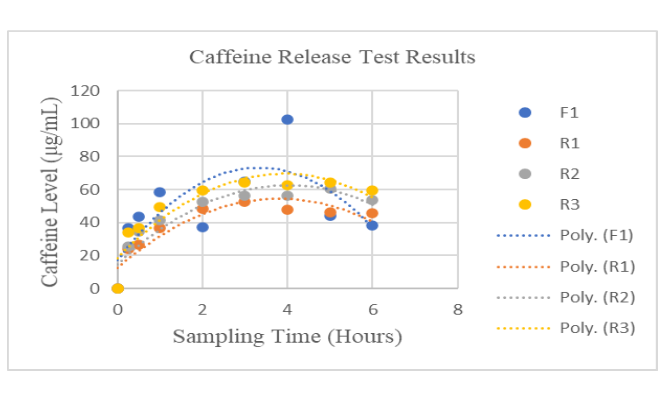Main Article Content
Abstract
Arabica coffee (Coffea arabica L.) kintamani is a superior agricultural product from Bali. Arabica coffee (Coffea arabica L.) contains many compounds, one of which is caffeine which is beneficial for health and beauty. This study aims to formulate kintamani arabica coffee beans into a gel dosage form. The optimization formula of kintamani arabica coffee bean gel was made using the D-Optimal method using a combination of HPMC and propylene glycol as observation variables and spreadability, pH, and viscosity of the gel preparation as experimental responses. The study of caffeine from the gel preparation was carried out using a Franz diffusion cell. Caffeine content in the gel preparation and its release are determined by spectrophotometric method. The results showed that the amount of HPMC used would increase the viscosity value (+14113.92) and decrease the spreadability (-0.29) and pH (-6.59167E-003) of the gel. The greater the amount of propylene glycol used will decrease the viscosity value (-2484.54) and increase the spreadability value (+0.30) and pH (+0.31802) of the gel. The conclusion of this study is the use of a combination of HPMC and propylene glycol (6%:17%) resulted in the optimum formula with a viscosity value of 44,070 cps, a spreadability value of 3.6 cm, and a pH value of 5.32. The caffeine content obtained in the gel preparation was 188.47 g and the amount of caffeine released from the gel preparation for 6 hours of testing was 4.95%.
Keywords
Article Details

This work is licensed under a Creative Commons Attribution-NonCommercial 4.0 International License.
References
- Ardana, M., Aeyni, V., & Ibrahim, A. (2015). Formulasi dan optimasi basis gel hpmc (. Journal of Tropical Pharmacy and Chemistry, 3(2), 101–108.
- Astuti, ika yuni, Hartati, D., & Aminati, A. (2010). Peningkatan Aktivitas Antijamur Candida Albicans Salep Minyak Atsiri Daun Sirih (Piper Bettle Linn.) Melalui Pembentukan Kompleks Inklusi Dengan β-Siklodekstrin. Majalah Obat Tradisional, 15(3), 94–99.
- Ayuningtyas, D. D. R., Nurahmanto, D., & Rosyidi, V. A. (2017). Optimasi Komposisi Polietilen Glikol dan Lesitin sebagai Kombinasi Surfaktan pada Sediaan Nanoemulsi Kafein. E-Jurnal Pustaka Kesehatan, 5(1), 157–163.
- Dewi, N. V., Fajaryanti, N., & Masruriati, E. (2017). Perbedaan Kadar Kafein Pada Ekstrak Biji , Kulit Buah Dan Daun Kopi (Coffea Arabica L.) Dengan Metode Spektrofotometri Uv-Vis Difference Between Kafein on Seed Extract , Leather Fruit and Coffee Leaves ( Coffea Arabica L .) With Method Spektrofotometri Uv. Jurnal Famasetis, 6(2), 29–38.
- Fajriana, N. H., & Fajriati, I. (2018). Analisis Kadar Kafein Kopi Arabika ( Coffea arabica L .) pada Variasi Temperatur Sangrai. Analit: Analytical and Environmental Chemistry, 3(02), 148–162.
- Farhaty, N. (2012). Tinjauan Kimia dan Aspek Farmakologi Senyawa Asam Klorogenat pada Biji Kopi: Review. Farmaka, 14, 214–227.
- Fitria, & Chandra, D. (2018). FORMULASI SEDIAAN GEL , KRIM , GEL-KRIM EKSTRAK BIJI KOPI ( Coffea arabica L .) SEBAGAI ANTISELULIT. Jurnal Ilmiah Farmasi Imelda, 2(2), 61–67.
- Garg, A., Aggarwal, D., Garg, S., & Singla, A. K. (2002). Spreading of semisolid formulations: An update. Pharmaceutical Technology North America, 26(9), 84–105.
- Gebeyehu, B. T., & Bikila, S. L. (2015). Determination of Caffeine Content and Antioxidant Activity of Coffee. American Journal of Applied Chemistry, 3(2), 69. https://doi.org/10.11648/j.ajac.20150302.16
- Ittiqo, D. H., & Anderiani, M. Y. (2017). Optimasi Formula Sediaan Krim Ekstrak Kulit Buah Naga Daging Merah (Hylocereus Polyrhizus). Cendekia Journal of Pharmacy, 1(1), 67–76. https://doi.org/10.31596/cjp.v1i1.9
- Kemenkes RI. (2020). Farmakope Indonesia edisi VI. In Departemen Kesehatan Republik Indonesia (VI).
- Mangku, I. G. P., Wijay, I. M. A. S., Ganda Putra, G. P. and, & Permana, D. G. M. (2018). Biological and Chemical Research. Journal of Biological and Chemical Research, 35(1), 48–52.
- Putra, S. K. B. (2016). Optimasi Formula Gel Hand Sanitizer Minyak Atsiri Jeruk Bergamot Dengan Komposisi HPMC dan Propilen Glikol. Universitas Sanata Dharma Yogyakarta, 1, 1–76. https://repository.usd.ac.id/4598/2/128114101_full.pdf
- Putri, Y. D., Warya, S., & Sembirirng, N. B. (2019). Formulasi Dan Evaluasi Sediaan Geol Antiselulit Kafein Dengan Penambahna Asam Glikolat Sebagai Enhancer. Jurnal Sains Dan Teknologi Farmasi Indonesia, 8(2), 48–59.
- Qisti, B. W. K., Nurahmanto, D., & Rosyidi, V. A. (2018). Optimasi Propilen Glikol dan Etanol sebagai Peningkat Penetrasi Ibuprofen dalam Sediaan Gel dengan Metode Simplex Lattice Design (Propylene Glycol and Ethanol Optimization as Ibuprofen Penetration Enhancer in Gel Dosage using Simplex Lattice Design Metho. Pustaka Kesehatan, 6(1), 11. https://doi.org/10.19184/pk.v6i1.6611
- Rawlins, E. A. (2002). Bentley’s textbook of pharmaceutics. (8th ed). All India Traveller Book Seller. https://www.worldcat.org/title/bentleys-textbook-of-pharmaceutics/oclc/956782935?referer=di&ht=edition
- Rosida, Sidiq, H. B. H. F., & Apriliyanti, I. P. (2018). Evaluasi Sifat Fisik Dan Uji Iritasi Gel Ekstrak Kulit Buah Pisang (Musa acuminata Colla). Journal of Current Pharmaceutical Sciences, 2(1), 131–135. https://journal.umbjm.ac.id/index.php/jcps/article/view/174
- Rowe, R. C., Sheskey, P. J., & Quinn, M. E. (2015). Linked data annotation and fusion driven by data quality evaluation. Revue Des Nouvelles Technologies de l’Information, E.28, 257–262.
- Setyawan, E. I., Warditiani, N. K., & Dewi, S. M. (2012). Pengaruh Penggunaan Propilenglikol dan Mentol Terhadap Matrik.
- Tranggono, R. I., & Latifah, F. (2007). Buku Pegangan Ilmu Pengetahuan KOSMETIK (J. Djajadisastra (ed.)). PT. Gramedia Pustaka Utama.
- Voigt, R., Noerono, & Soendani. (1994). Buku pelajaran teknologi farmasi (E.d.3, pen). Gadjah Mada University Press.
- Wilantari, P. D., Putri, N. R. A., Putra, D. G. P., Nugraha, I. G. A. A. K., Syawalistianah, Prawitasari, D. N. D., & Samirana, P. O. (2018). Isolasi Kafein Dengan Metode Sublimasi Dari Dengan Fraksi Etil Asetat Serbuk Daun Camelia Sinensis. Jurnal Farmasi Udayana, 8(1), 53. https://doi.org/10.24843/jfu.2018.v07.i02.p03
